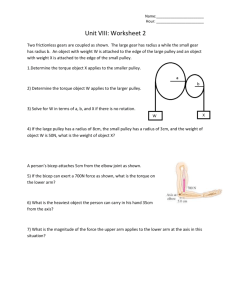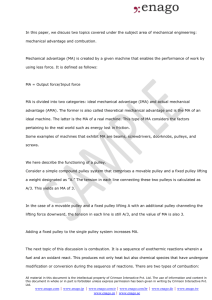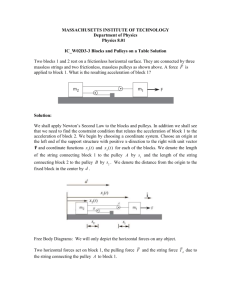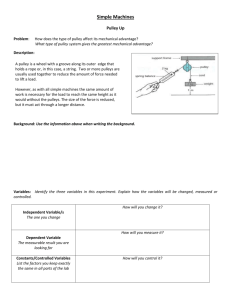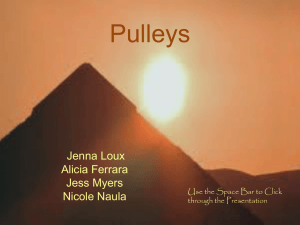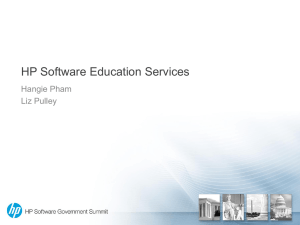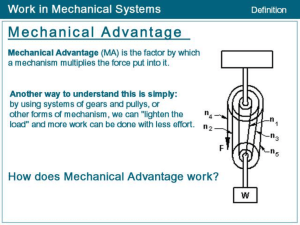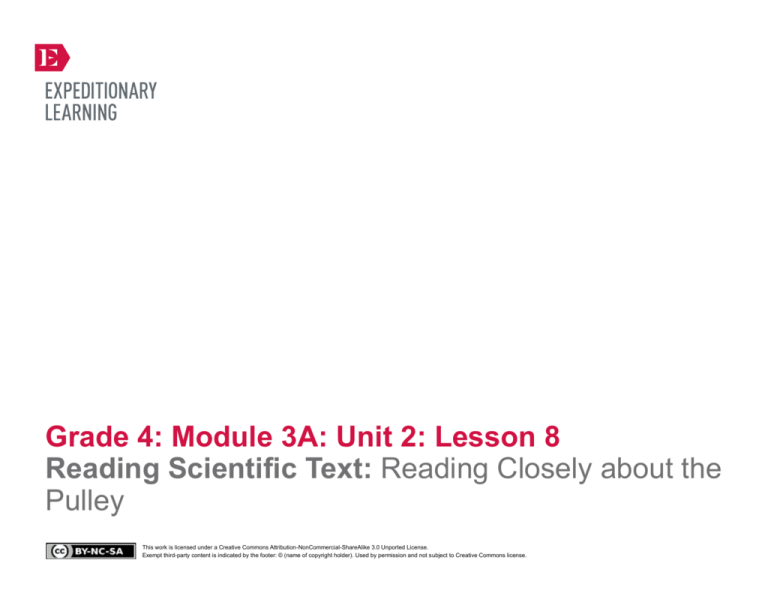
Grade 4: Module 3A: Unit 2: Lesson 8
Reading Scientific Text: Reading Closely about the
Pulley
This work is licensed under a Creative Commons Attribution-NonCommercial-ShareAlike 3.0 Unported License.
Exempt third-party content is indicated by the footer: © (name of copyright holder). Used by permission and not subject to Creative Commons license.
GRADE 4: MODULE 3A: UNIT 2: LESSON 8
Reading Scientific Text:
Reading Closely About the Pulley
Long-Term Targets Addressed (Based on NYSP12 ELA CCLS)
I can determine the meaning of academic words or phrases in an informational text. (RI.4.4)
I can determine the meaning of content words or phrases in an informational text. (RI.4.4)
I can explain the main points in a scientific text, using specific details in the text. (RI.4.3)
I can choose evidence from informational texts to support analysis, reflection, and research. (W.4.9)
Supporting Learning Targets
Ongoing Assessment
• I can find the meaning of scientific and academic words related to the pulley.
• Simple Machines Science journal (page 16: Pulley
Research Notes)
• I can determine important information about pulleys and how they help people do work.
• Vocabulary note-catcher
• Diagram
• Constructed Response
Copyright © 2013 by Expeditionary Learning, New York, NY. All Rights Reserved.
NYS Common Core ELA Curriculum • G4:M3A:U2:L8 • June 2014 •
1
GRADE 4: MODULE 3A: UNIT 2: LESSON 8
Reading Scientific Text:
Reading Closely About the Pulley
Agenda
Teaching Notes
1. Opening
• The structure of this lesson is similar to Lessons 3 and 5. Students learn about pulleys, focusing on how
the pulley is similar to and different from other simple machines.
A. Engaging Readers and Writers: Revisiting the KWL
Chart (10 minutes)
B. Reviewing Learning Targets (5 minutes)
2. Work Time
A. Partner Reading: Reading a Scientific Text about the
Pulley Closely (25 minutes)
B. Connecting Key Vocabulary (15 minutes)
3. Closing and Assessment
A. Share: Single versus Double Pulleys (5 minutes)
• In the second half of this unit, students continue to read about simple machines and conduct
experiments, but they do this more independently. Therefore, unlike in the first half of the unit,
students read closely (in Lessons 8 and 9) BEFORE doing the experiment (in Lesson 10). This helps
them see how they are developing as readers. They can learn a lot about simple machines before doing
the experiment in Lesson 10.
• Work Time A and B in this lesson is primarily partner work. Some students may need more support.
Consider pulling partnerships together for additional support in processing content and/or defining the
meanings of unfamiliar words.
• In advance: Make a Pulleys anchor chart with three sections. (See model in supporting materials.)
• Post: Learning targets.
4. Homework
A. Write a caption for the pulley diagram on the front
of your Science journal. Make sure to describe how a
pulley helps people do work.
Lesson Vocabulary
Materials
pulley, reduce, increase, decrease,
antonyms; complicated, laborers,
distance
• KWL anchor chart (from Lesson 1)
Review: force, load, effort
• Sticky note (one per partnership)
• Simple Machines Science journals (from Lesson 1)
• Simple Machines: Forces in Action pages 30–31 (book, one per student)
• Vocabulary Strategies anchor chart (reviewed in Unit 1, Lesson 1)
• Sticky notes (one per student)
• Blank paper (one per student)
• Pulleys anchor chart (newly created; for teacher reference)
Copyright © 2013 by Expeditionary Learning, New York, NY. All Rights Reserved.
NYS Common Core ELA Curriculum • G4:M3A:U2:L8 • June 2014 •
2
GRADE 4: MODULE 3A: UNIT 2: LESSON 8
Reading Scientific Text:
Reading Closely About the Pulley
Meeting Students’ Needs
Opening
A. Engaging Readers and Writers: Revisiting the KWL Chart (10 minutes)
• Post the KWL anchor chart. Remind students that in Lesson 1 of this unit, they used this chart to write down what they
knew about simple machines and any questions they had. They’ve learned a lot since that lesson; it’s time to revisit and
revise the KWL chart.
• Distribute the Simple Machines Science journals and ask the students to turn to page 10.
• Ask students to do the following:
1. Review the information that they listed in the “I KNOW …” column to check for accuracy.
2. Mark the information Y or N if they have learned that, yes (Y), it is accurate, or no (N), it is inaccurate, from all they have
read and experienced so far in this unit. Tell them not to write any new information in this column.
3. List new learning in the last “I LEARNED …” column. Point out they are asked to not only identify the information they
have learned, but also where they learned it—the source. For example:
– Information: A lever is made up of a bar that tilts on a special point called a fulcrum.
– Source: Simple Machines, page 24 (Students could abbreviate the title of the book as SM.)
• Give students 5 minutes to record as much new learning as they can. Tell them they will revisit this chart again after Lesson
9.
• Cold call two or three students to share one piece of information they’ve learned and where they learned it. Add this
information to the KWL anchor chart.
B. Reviewing Learning Target (5 minutes)
• Invite the students to read the learning targets. Ask them to show they understand what they will be learning by touching
their noses. If they are unsure of what the learning targets say, ask them to scratch their heads. Clarify as needed.
Copyright © 2013 by Expeditionary Learning, New York, NY. All Rights Reserved.
NYS Common Core ELA Curriculum • G4:M3A:U2:L8 • June 2014 •
3
GRADE 4: MODULE 3A: UNIT 2: LESSON 8
Reading Scientific Text:
Reading Closely About the Pulley
Work Time
Meeting Students’ Needs
A. Partner Reading: Reading a Scientific Text about the Pulley Closely (25 minutes)
• Explain students will read a text about pulleys with their science partner from Lesson 4. Distribute Simple Machines:
Forces in Action pages 30–31 and one sticky note per partnership and ask students to turn to page 30. Review the
process of closely reading a text that they have experienced during this unit.
• For students needing additional
support, consider the following:
1. Read the entire text.
2. Discuss what the gist of the text is and write it on a sticky note.
3. Read the text again to identify key scientific vocabulary. Refer to the Vocabulary Strategies anchor chart for
strategies to use in determining the meaning of unfamiliar words.
4. Identify vocabulary in the Vocabulary section of the Simple Machines Science journal. Make sure to locate: pulley,
reduce, decreased, increased, force, load, effort, distance.
5. Read the text again, determining important information and using evidence from the text to support your thinking.
Remind students of the process of deconstructing complex sentences and paragraphs to better understand challenging
scientific content (Lessons 3 and 5). Encourage them to use the diagrams on page 30 to help them understand the
difference between single and double pulleys as they read.
• Explain that they will work together to complete the first two sections of the Pulley Research Notes on page 16 in their
Simple Machines Science journal. Remind students they’ve done this process twice before, so today they are going to do it
more on their own. Tell them that they will work with a new science partner. Also tell them you are available for support.
• As pairs work, circulate and assist as needed. Ask questions to help push the students back to the text to cite evidence that
supports their thinking. For example: “Where in the text does it say that?” or “Are you sure? How do you know?” Give
students specific praise when they cite textual evidence.
Copyright © 2013 by Expeditionary Learning, New York, NY. All Rights Reserved.
– Pull small groups of students who
have similar skills/needs.
– Provide sentence stems for the
gist statements to help students
who struggle with language.
– Students needing additional
supports may benefit from
partially filled-in graphic
organizers. (See task cards in
Module 2, Unit 2, Lesson 6.)
• Consider partnering an ELL with a
student who speaks the same L1
when discussion of complex content
is required. This lets students have
more meaningful discussions and
clarify points in their L1.
• Students who struggle with
language benefit from having their
own individual dictionaries for
reference throughout the module.
NYS Common Core ELA Curriculum • G4:M3A:U2:L8 • June 2014 •
4
GRADE 4: MODULE 3A: UNIT 2: LESSON 8
Reading Scientific Text:
Reading Closely About the Pulley
Work Time (continued)
Meeting Students’ Needs
B. Connecting Key Vocabulary (15 minutes)
• Ask students what the word interconnected means. Remind them that they learned about that word in Lesson 3 when they
read about the inclined plane. Ask them to turn and talk with a partner. Once they have a definition in mind, they should put
a thumbs-up sign in front of their chest. When all students have indicated they have a definition ready to share, ask them to
lift their faces to the ceiling and on the count of three, whisper their definition “to the universe.” Count: “One, two, three!”
You should hear: “Joined together.”
• Using sentence frames can help
ELLs articulate their learning.
• Write the following words on the white board or chart paper: distance, increase, decrease, effort. Ask students to look back
in their Science journals to review what these words mean.
– distance: the measure of space between two points
– increase: make greater
– decrease: make less
– effort: the force needed to use a simple machine
• Ask students to pair up, and assign each pair one of the three passages. Each partnership will do the following:
1. Review a page in Simple Machines: Forces in Action together by choral reading.
– inclined plane (“Historic Planes” and “Distance versus Effort”), page 7
– lever (“Effort and Load”), page 25
– pulley (“Easy Lifting” and “Powerful Pulleys”), page 31
2. Work together to answer the question: “How are distance and effort interconnected for your simple machine? Use
evidence from the text to support your answer.”
3. Write your answer on a large sticky note.
• Model this process using the screw. Ask students to turn to page 19 in Simple Machines: Forces in Action. Read the first
paragraph aloud as the students read silently. Focus on the last sentence: “Less effort is needed to cut into the wood because
of the increased distance that the threads travel.” Think aloud how the terms distance and effort are used. For example: “The
text is saying that the threads of a screw turn over and over—a longer distance, but with little more effort than trying to force
the lid to close by pushing down on it with great force.”
Copyright © 2013 by Expeditionary Learning, New York, NY. All Rights Reserved.
NYS Common Core ELA Curriculum • G4:M3A:U2:L8 • June 2014 •
5
GRADE 4: MODULE 3A: UNIT 2: LESSON 8
Reading Scientific Text:
Reading Closely About the Pulley
Meeting Students’ Needs
Work Time (continued)
• Give the students 15 minutes to read the identified pages in Simple Machines: Forces in Action and answer the textdependent question.
• Circulate and offer support as needed.
Closing and Assessment
Meeting Students’ Needs
A. Share: Single versus Double Pulleys (5 minutes)
• Distribute a piece of blank paper to each student. Ask them to reread the first paragraph on page 31 and draw a picture
that represents the difference between a single pulley and a double pulley. Encourage them to look at the diagrams on page
30 for help. Inform them they will need to be able to explain this scientific concept to another student.
• Providing word banks for students
who struggle with language will give
them additional support in
answering complex questions.
• Give the students 3 minutes to reread the text and create their visual representation.
• Ask them to find a partner to share their diagrams and how the pulleys are different.
Copyright © 2013 by Expeditionary Learning, New York, NY. All Rights Reserved.
NYS Common Core ELA Curriculum • G4:M3A:U2:L8 • June 2014 •
6
GRADE 4: MODULE 3A: UNIT 2: LESSON 8
Reading Scientific Text:
Reading Closely About the Pulley
Meeting Students’ Needs
Homework
• Look for pulleys around you (at school or at home). Record examples to share in our next lesson. Either take pictures of the
pulleys, make a sketch of what you saw, or use words to describe what you saw.
• Write a caption for the pulley diagram on the front of your Simple Machines Science journal. Make sure to describe how a
pulley helps people do work.
Note: Lesson 10 (two lessons from now) includes two experiments. Half of the class will do an experiment about pulleys; the
other half will do an experiment about the wheel and axle. They then share what they learned with peers who performed the
other experiment. In advance, review procedures and prepare materials: see pages 32 to 33 of Simple Machines: Forces in
Action for the pulley experiment and pages 38 to 39 for the wheel and axle one. If it’s not possible to gather all of the
experiment materials, consider these alternatives:
Pulley:
– If empty thread spools are not available, try either empty toilet paper rolls or cut a wooden dowel, such as a closet rod,
into two-inch sections. Wrap rubber bands around each end of the dowel/roll to keep the string of the pulley from
slipping off.
– If small buckets are not available, try plastic cups with string handles.
– For a fixed point on which to hang the pulleys, use the leg of a desk chair on its side on a flat surface (i.e., table or desk).
To be sure that the chair does not fall off the flat surface, use some kind of anchor weight (i.e., heavy books, one of the
students holding it with their hands, or tie the chair down) holding it securely on the surface.
Wheel and Axle:
– If roller skates are not available, try any smaller toy on wheels (i.e., cars, trucks). Make sure the toys weigh enough to
cause friction when on their sides. Consider securing a small bag of gravel to the wheeled object.
Copyright © 2013 by Expeditionary Learning, New York, NY. All Rights Reserved.
NYS Common Core ELA Curriculum • G4:M3A:U2:L8 • June 2014 •
7
Grade 4: Module 3A: Unit 2: Lesson 8
Supporting Materials
This work is licensed under a Creative Commons Attribution-NonCommercial-ShareAlike 3.0 Unported License.
Exempt third-party content is indicated by the footer: © (name of copyright holder). Used by permission and not subject to Creative Commons license.
GRADE 4: MODULE 3A: UNIT 2: LESSON 8
Pulleys Anchor Chart
(For Teacher Reference)
(Example is not to scale—create this anchor chart in advance)
Pulleys
Gist Statements:
(Student sticky notes)
Important Vocabulary to Know:
(Student sticky notes)
Examples of Pulleys in Our Lives:
(Student sticky notes)
Copyright © 2013 by Expeditionary Learning, New York, NY. All Rights Reserved.
NYS Common Core ELA Curriculum • G4:M3A:U2:L8 • June 2014 •
9


